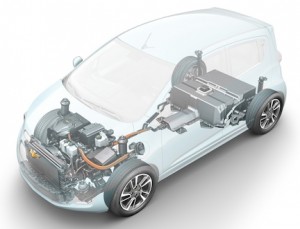 The following is an excerpt from the book Save Gas, Save the Planet. Copyright ©John Addison. All rights reserved.
The following is an excerpt from the book Save Gas, Save the Planet. Copyright ©John Addison. All rights reserved.
Most of us drive vehicles powered with internal combustion engines. Tiny explosions in cylinders cause shafts to turn which deliver power to wheels. Energy is stored in liquid fuel, most often gasoline or diesel.
Electric vehicles use electric motors not internal combustion engines. You can probably find a number of smaller electric motors in your house running everything from the washing machine to the garbage disposal. You might also have a cordless power tool that you charge and then run with power from the internal battery. Electric cars use the same approach. Plug in to charge the batteries and then drive away.
Although many people will be happy with the electric vehicle choices now offered, others would want more range, larger vehicles, and lower prices. All this is increasingly possible through steady advancements being made with battery and energy storage.
Early electric vehicles used lots of lead-acid batteries. Gasoline cars only need one lead-acid battery to power the radio and other accessories. Electric vehicles need far more battery power to provide a steady stream of electricity to an electric motor or motors. Lead-acid batteries are less expensive than more modern batteries, but they take up too much room and add too much weight to electric vehicles.
Nickel metal hydride has been the battery chemistry of choice for hybrid-electric vehicles. These batteries often deliver twice the power per weight over lead-acid. Nickel metal hydride costs more than lead-acid, but less than lithium batteries.
Lithium batteries often deliver twice the power per weight compared with nickel metal hydride, and at least four times lead-acid. Because lithium batteries cost more, they are not used in most hybrid vehicles. Lithium batteries are the energy storage of choice for electric vehicles and plug-in hybrids. Taking limited space on the vehicle, enough lithium batteries can be used to deliver 15 to 300 miles of travel only using the energy stored in the batteries. With more batteries large and heavy buses and delivery trucks run over 100 miles using only battery-stored energy.
The lithium batteries in the new electric vehicles are similar to the lithium batteries used in your notebook computers and mobile phones. Because millions of lithium batteries are manufactured daily, battery costs have dropped. To deal with the high cost of lithium batteries, some automakers use kits that integrate thousands of consumer-size lithium batteries.
When you store a lot of energy in a small place, there is the potential for fires and explosions. Every year people die from gasoline fires that started when someone crashed. Under some circumstances, batteries can also catch fire and even explode. Lithium can be vulnerable to thermal runaways, and although there is no evidence that electric vehicles are less safe than their gasoline cousins, safety is a concern.
Hundreds of lithium battery makers have developed sophisticated chemical combinations to make their batteries safer and deliver more for the money. Lithium batteries are used with special cathodes made of nanophosphate, lithium nanotitanate, manganese titanium, and other combinations of chemicals as companies optimize some batteries for quick acceleration, others for more range, and always for longer battery life and better safety.
Another type of energy storage is ultracapacitors, which are very efficient at storing energy, such as energy from braking, and delivering energy over brief periods of time. Some hybrid buses that stop at every corner use ultracapacitors, not batteries. Some power tools use combinations of ultracapacitors and lithium batteries to get the best of both. General Motors is evaluating using both ultracapacitors and lithium batteries in future generations of cars.
There are a number of other battery chemistries that can be found in specialty vehicles — from nickel cadmium to nickel salt. Currently vehicle makers are focused on three battery types, depending on whether they just need to power a few accessories or build a hybrid or build a battery electric vehicle – lead-acid, nickel metal hydride, and lithium. Somewhere in the future, a new form of energy storage may replace all three.
Get your discounted paperback or eBook copy of Save Gas, Save the Planet at Amazon. Gain a comprehensive understanding of electric cars, low-carbon fuels, and sustainable transportation.

